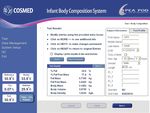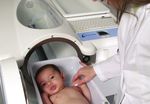Numbers you can trust - The world's gold standard for non-invasive infant body composition assessment - Cosmed
←
→
Page content transcription
If your browser does not render page correctly, please read the page content below
ADP is a noninvasive, reliable, and accurate technique to measure infants’
body composition in both research and clinical settings(1)
® Gold Standard accuracy using whole-
body densitometry
® Testing pre-term and term infants
(1 to 8 kg )
® Fat and Fat-Free Mass measurements
® Accomodates most infant behaviors
(crying, movement, etc.)
® Safe, non-invasive, and ideally suited
for frequent testing
® Excellent test-retest reliability
® Fast test time (only 2 minutes inside
the chamber)
Researchers widely recognize that the accu-
rate assessment and tracking of body compo-
Main Applications Test Sequence
The PEA POD is an important tool that The PEA POD is extremely simple to operate,
sition in the critical period immediately
enables a better understanding of fetal with software prompts guiding the oper-
following birth and throughout early life can
programming, the assessment of efficacy of ator through each step of the process. From
provide key information in both clinical and
nutritional therapies, and the development start to finish, a PEA POD test takes about 7
research settings. This includes developing
of normative body composition data among minutes:
nutrition guidelines, NICU release criteria,
dosage requirements, and acquiring norma- other applications. It is used in a wide variety ■ Basic information is entered into the
tive growth data. of segments: software program while the automatic
■ Academic and Medical Research volume calibration takes place.
The PEA POD is the world’s only Air Displace-
ment Plethysmography system using whole ■ Neonatology Departments ■ Body mass is measured with a high
body densitometry to determine body ■ Nutrition Assessment Centers precision electronic load cell scale
composition (Fat and Fat-Free Mass) in infants embedded in the unit (its accuracy
weighing between 1 and 8 kg. is assured by calibrations at regular
intervals).
Each PEA POD is a complete turnkey system
based on the same Gold Standard oper- Proven Accuracy ■ Infant is placed in the PEA POD test
ating principle as hydrostatic (underwater) The PEA POD uses the principles of whole- chamber tray and enters the warmed
weighting. body densitometry to determine body test chamber for a 2-minute volume
composition. In this technique, body mass measurement. During the entire period
The PEA POD is extremely simple to use the infant is clearly visible at all time
and does not require a license to operate. and body volume are measured (both
through the unit window.
It is also completely non-invasive and ideal performed within the unit). Once body
density (Density = Mass/Volume) is deter- ■ Test results are computed, displayed
for frequent, longitudinal tracking of body
mined, the PEA POD uses known (or user and printed.
composition.
customized) densitometric equations to
calculate percent Fat and Fat-Free Mass. The
accuracy of the PEA POD has been shown to
be very high against reference techniques in
a number of research publications.
(1) Roggero P et al “Evaluation of air-displacement pleth-
ysmography for body composition assessment in preterm
infants.” Pediatr Res. 2012 Sep;72(3):316-20.Software Features Maintenance Safety
■ Longitudinal reports of body composi- The PEA POD is designed for durability over The PEA POD is manufactured in compliance
tion changes. time. Each PEA POD has an internal diag- with the strictest quality standards required
■ Customizable body composition ranges. nostic test function to analyze system perfor- for medical devices.
mance and provide feedback to service The PEA POD adopts the same safety criteria
■ Customizable density models based on
personnel. Extended service agreements are of an incubator. The chamber is kept in
ethnicity and gender.
available to insure optimal performance for constant temperature, constantly ventilated,
■ Data export capability. long term use. and an integrated sensor monitors continu-
ously the level of CO2 inside the chamber to
activate visual and audible alarms to alert
the user of any abnormal function. In addi-
tion, the PEA POD has a HEPA filter to protect
against airborne disease transmission.
The PEA POD has also a redundant safety
system, consisting of a Cancel Test button
and an Emergency STOP knob the operator
can use to immediately stop/cancel a test
and remove the subject.
User-friendly and straightforward software interface High precision scale embedded in the unit
®
PEA POD Infant Body Composition System Analysis
County General Hospital Customisable header
123 Maple St.
Hope City, MI 55555
HISTORY - % FAT NORMATIVE DATA* SUBJECT INFORMATION
TEST DATE DATA MEAN +1 SD -1 SD FIRST NAME Lisa
11/10/2003 12:21:19 PM 9.5 ----- ----- ----- MIDDLE NAME
11/12/2003 1:15:00 PM 9.8 ----- ----- ----- LAST NAME Adams
11/15/2003 12:36:00 PM 9.7 ----- ----- ----- GESTATIONAL AGE 35.0 Weeks
11/18/2003 12:02:00 PM 10.1 ----- ----- ----- DATE OF BIRTH 11/10/2003
11/21/2003 11:47:00 AM 9.5 ----- ----- ----- GENDER Female Subject information
11/24/2003 12:56:00 PM 9.9 ----- ----- ----- ID_1 555-55-5555
12/1/2003 1:47:00 PM 10.5 ----- ----- -----
ID_2 AA 55 21
12/8/2003 11:36:00 AM 10.4 10.9 20.5 1.2
GROUP None
12/15/2003 11:15:19 AM 10.3 12.5 21.8 3.1
12/22/2003 11:03:00 AM 12.8 14.1 23.1 5.1 COMMENTS
12/29/2003 1:22:00 PM 14.2 15.7 24.4 7.0
1/5/2004 10:51:00 AM 17.5 17.3 25.7 8.9
1/19/2004 11:19:00 AM 20.1 20.5 28.2 12.7
2/2/2004 11:41:00 AM 23.5 23.6 30.8 16.5
2/16/2004 12:23:00 PM 27.6 26.8 33.4 20.3 History of %FAT
3/1/2004 11:33:00 AM 31.1 30.0 35.9 24.1
3/15/2004 10:57:00 AM 34.6 31.5 37.0 26.0 measurements
3/29/2004 11:02:00 AM 36.4 31.6 36.9 26.3
4/12/2004 11:20:00 AM 35.4 31.7 36.8 26.6
4/26/2004 12:02:00 PM 34.2 31.8 36.7 26.8 The infant is easily placed in the warmed test chamber
HISTORY GRAPH - % FAT
45.0 % 39 W eeks
Gest. Age
12/8/03
40.0 %
*
35.0 %
*
Graph representing history
30.0 %
* of %FAT measurements
% FAT
25.0 %
20.0 %
15.0 %
10.0 %
5.0 %
0.0 %
11/10/2003
11/24/2003
12/8/2003
12/22/2003
1/19/2004
2/16/2004
3/15/2004
3/29/2004
4/12/2004
4/26/2004
5/10/2004
1/5/2004
2/2/2004
3/1/2004
DOB
*Normative data are calculated based on results by Butte NF, Hopkinson JM, Wong WW, Smith EO, Ellis KJ. Body composition during the first
2 years of life: an updated reference. Pediatr Res 2000;47:578-85. Data provided are for informational purposes only and are not intended as a
substitute for advice provided by physician or other medical professional.
COSMED USA, Inc. • www.cosmed.com
Reports can be created showing longitudinal changes in body composition The infant is clearly visible at all time through the
over time with reference values for comparison unit windowValidation articles Technical Specifications
• Forsum E, et al “An Evaluation of the Pea Pod System for
Assessing Body Composition of Moderately Premature
Product Description REF
Infants” Nutrients 2016, 8(4), 238 PEA POD Infant ADP body composition tracking system A-661-230-025
• Fields DA et al “Air Displacement Plethysmography: Cradle Standard packaging PEA POD unit; Computer/monitor; Software Disk; Volume panthom; 2 Kg. calibration
to Grave” Nutr Clin Pract. 2015 Mar 11 weight; Chamber tray allen key; Door strap (placed on PEAD POD door); Subject cap (10
• Roggero P et al “Evaluation of air-displacement plethys-
pcs.); Window cleaner; Window cleaning cloths (5 pcs.); Keyboard membrane; Printer; Air
mography for body composition assessment in preterm
infants” Pediatr Res. 2012 Sep; 72(3):316-20. intake pre-filter (4 pcs.); Operator’s manual.
• Ellis KJ, et al “Body-composition assessment in infancy: Standard Tests
air-displacement plethysmography compared with a Body Composition Body Weight, Body Fat (mass and %), Body Fat-Free (mass and %), Body surface area,
reference 4-compartment model” Am J Clin Nutr. 2007
Jan; 85(1):90-5. Thoracic Gas Volume (estimated)
• Ma G, et al “Validation of a new pediatric air-displace- Accuracy The mean difference of measured body fat percentage is < 0.6 % when compared to
ment plethysmograph for assessing body composition in reference techniques (such as deuterium dilution method and four compartment models)
infants“ Am J Clin Nutr. 2004 Apr; 79(4):653-60. Maximum patient weight 8 kg
• More scientific studies on
www.cosmed.com/bibliography Mass Measurement (with built-in digital scale)
Weight range up to 10Kg
Accuracy ±2g
Calibration Certified 2Kg weight
Volume Measurement
Dimensions & Weight (Pod) 156.2x79.8x122.4 cm / 300kg
Chamber volume ≈ 36L
Accuracy ±6 ml
Calibration Automatic with an internal calibration volume
Hardware
Power requirements 100-240V ± 10% 50/60 Hz
Environmental conditions
Temperature 20 to 28°C (operating); -21 to 75°C (storage)
Humidity 20-70% (non-condensing)
Barometric Pressure 75-106 KPa (562-795 mm Hg)
Software PEA POD Suite
Available languages English
PC Configuration Windows XP Pro (32 bit), Windows 7 (32 bit) or Windows 10 (64bit); 256 MB RAM (XP
(PC included) Pro), 2 GB RAM (Windows 7)
Safety & Quality Standards
MDD (93/42 EEC); FDA 510(k); EN 60601-1 (safety) / EN 60601-1-2 (EMC)
6 � (1.8 m) 0413
PEA POD
© 2020/02-a COSMED E & OE. Subject to alterations without prior notice. REF C03838-02-93
8 � (2.4 m)
8 � (2.4 m)
Open Door Technician
Patient Tray
PEA POD is manufactured by COSMED USA
COSMED Srl COSMED USA, Inc.
To know more:
Via dei Piani di Monte Savello 37 1850 Bates Avenue
Albano Laziale - Rome 00041, Italy Concord, CA USA 94520
+39 (06) 931-5492 Phone T. +1 (925) 676-6002 Phone
+39 (06) 931-4580 Fax F. +1 (925) 676-6005 Fax
info@cosmed.com | cosmed.com info@cosmed.com | cosmed.comYou can also read

























































